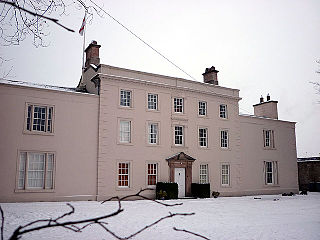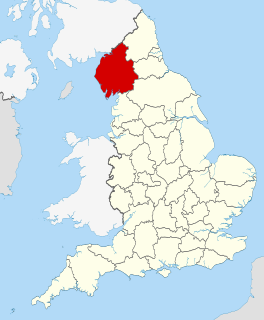
Levens Hall is a manor house in the Kent valley, near the village of Levens and 5 miles (9 km) south of Kendal in Cumbria, Northern England.

Dovenby Hall is a country house in 115 acres (47 ha) of land at Dovenby, about 2 miles (3.2 km) north-west of Cockermouth, Cumbria, England. It is a Grade II listed building.

The River Winster is a river in the English county of Cumbria. The Winster was the boundary between the ancient counties of Lancashire and Westmorland. It has a relatively small catchment area; other streams flow parallel to it on either side.

Rydal Hall is a large detached house on the outskirts of the village of Rydal, Cumbria, in the English Lake District. It has an early nineteenth-century front facade, but includes some earlier fabric.

Graythwaite Hall, near Hawkshead, Cumbria in the Lake District of England is the home of the Sandys family. The gardens within the grounds are open to the public from early April until mid August, However, the hall is closed to the public.

Hutton in the Forest is a Grade I listed country house near the village of Skelton in the historic county of Cumberland, which now forms part of the modern county of Cumbria, England. It has belonged to the Fletcher-Vane family, latterly the Barons Inglewood, since 1605.

Cliburn is a village and civil parish in the Eden District of Cumbria, England. The civil parish includes the hamlet of Town Head. In 2001 the population was 204, increasing to 274 at the 2011 Census.
Hollin Old Hall is a house in Bollington, Cheshire, England. The oldest part of the house dates from the 17th century. In the middle of the 18th century the roof was raised, and an addition was made to the rear of the house for Richard Broster. It was remodelled and expanded in about 1870 for the Ascoli family. The building has since been divided into two houses. It is constructed in coursed buff sandstone rubble, with a Kerridge stone-slate roof, a stone ridge, and stone chimneys. The house is in two storeys over a barrel-roofed cellar. The main front has three bays with 19th-century four-light windows, and two gables, each with a two-light window. Elsewhere the house is in Jacobean style, with windows that are mullioned and transomed, or just mullioned. In the cellar is a large slab inscribed "This must stand here forever, Richard Broster 1757". The house is recorded in the National Heritage List for England as a designated Grade II listed building.

Kentrigg is a northern suburb of Kendal, Cumbria, England. By road, Kentrigg is located 1.2 miles (1.9 km) north of the centre of Kendal and 1.4 miles (2.3 km) southeast of Burneside. It contains the Carus Green Golf Club, which separates it from Burneside just to the northwest. Across the River Kent to the east is the Shap Road Industrial Estate, north of the district of Mintsfeet and the Mintsfeet Industrial Estate which marks the southeastern side of Kentrigg.

Dalemain is a country house 10 miles south-west of Penrith in Cumbria. It is a Grade I listed building.

Workington Hall, sometimes called Curwen Hall, is a ruined building on the North-East outskirts of the town of Workington in Cumbria. It is a Grade I listed building.

Askham Hall is a country house near Askham in Cumbria. It is a Grade I listed building.

Crook Hall is a 14th-century Grade I listed manor house which stands off Sidegate in the Framwelgate area of the city of Durham. The House and Gardens are open for the public to view, Children's events and Weddings are held through the year, Afternoon Tea is very popular in the Georgian House and Gardens and there are two self-catering apartments on site.

Ashton House is a large country house in Beetham in Cumbria. It is a Grade II* listed building.

Dalston Hall is a fortified country house at Dalston in Cumbria. It is a Grade II* listed building.
Helsfell Hall was a country house near Kentrigg in Cumbria. That part of the building which survives, and is now used as a barn, is a Grade II listed building.

Cowmire Hall is a country house near Crosthwaite in Cumbria, England. The hall, the garden wall and gate piers are recorded in the National Heritage List for England as a designated Grade II* listed building.

Winster is a village in the South Lakeland District of Cumbria, in North West England. Historically within the county of Westmorland, it is situated less than two miles east of Windermere, England's largest natural lake. The village is within the Lake District National Park. The village has a pub, the Brown Horse Inn, an 1850s coaching inn.
Crook is a civil parish in the South Lakeland District of Cumbria, England. It contains 18 listed buildings that are recorded in the National Heritage List for England. All the listed buildings are designated at Grade II, the lowest of the three grades, which is applied to "buildings of national importance and special interest". The parish is in the Lake District National Park to the east of the southern part of Windermere. It contains the villages of Crook and Winster, and is otherwise rural. Most of the listed buildings are houses with associated structures, farmhouses, and farm buildings. The other listed buildings are the tower of a disused church, a packhorse bridge, a public house, and a school.























